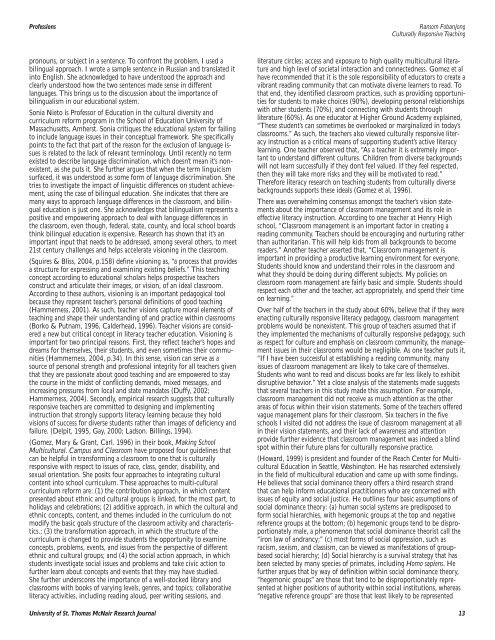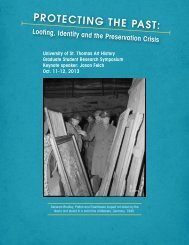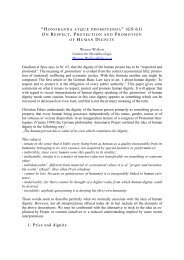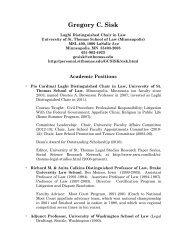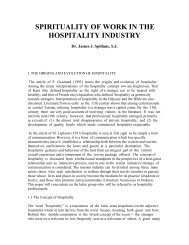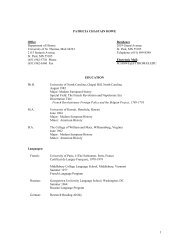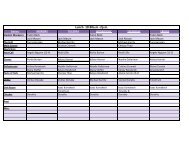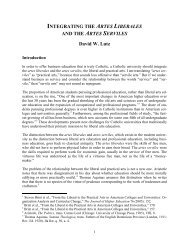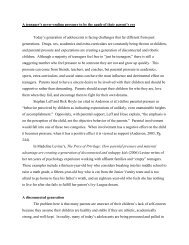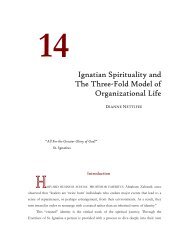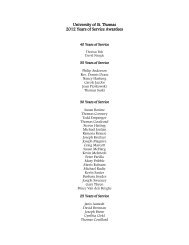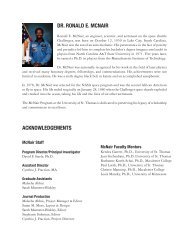McNair Research Journal - University of St. Thomas
McNair Research Journal - University of St. Thomas
McNair Research Journal - University of St. Thomas
You also want an ePaper? Increase the reach of your titles
YUMPU automatically turns print PDFs into web optimized ePapers that Google loves.
Pr<strong>of</strong>essions<br />
pronouns, or subject in a sentence. To confront the problem, I used a<br />
bilingual approach. I wrote a sample sentence in Russian and translated it<br />
into English. She acknowledged to have understood the approach and<br />
clearly understood how the two sentences made sense in different<br />
languages. This brings us to the discussion about the importance <strong>of</strong><br />
bilingualism in our educational system.<br />
Sonia Nieto is Pr<strong>of</strong>essor <strong>of</strong> Education in the cultural diversity and<br />
curriculum reform program in the School <strong>of</strong> Education <strong>University</strong> <strong>of</strong><br />
Massachusetts, Amherst. Sonia critiques the educational system for failing<br />
to include language issues in their conceptual framework. She specifically<br />
points to the fact that part <strong>of</strong> the reason for the exclusion <strong>of</strong> language issues<br />
is related to the lack <strong>of</strong> relevant terminology. Until recently no term<br />
existed to describe language discrimination, which doesn’t mean it’s nonexistent,<br />
as she puts it. She further argues that when the term linguicism<br />
surfaced, it was understood as some form <strong>of</strong> language discrimination. She<br />
tries to investigate the impact <strong>of</strong> linguistic differences on student achievement,<br />
using the case <strong>of</strong> bilingual education. She indicates that there are<br />
many ways to approach language differences in the classroom, and bilingual<br />
education is just one. She acknowledges that bilingualism represents a<br />
positive and empowering approach to deal with language differences in<br />
the classroom, even though, federal, state, county, and local school boards<br />
think bilingual education is expensive. <strong>Research</strong> has shown that it’s an<br />
important input that needs to be addressed, among several others, to meet<br />
21st century challenges and helps accelerate visioning in the classroom.<br />
(Squires & Bliss, 2004, p.158) define visioning as, “a process that provides<br />
a structure for expressing and examining existing beliefs.” This teaching<br />
concept according to educational scholars helps prospective teachers<br />
construct and articulate their images, or vision, <strong>of</strong> an ideal classroom.<br />
According to these authors, visioning is an important pedagogical tool<br />
because they represent teacher’s personal definitions <strong>of</strong> good teaching<br />
(Hammerness, 2001). As such, teacher visions capture moral elements <strong>of</strong><br />
teaching and shape their understanding <strong>of</strong> and practice within classrooms<br />
(Borko & Putnam, 1996, Calderhead, 1996). Teacher visions are considered<br />
a new but critical concept in literacy teacher education. Visioning is<br />
important for two principal reasons. First, they reflect teacher’s hopes and<br />
dreams for themselves, their students, and even sometimes their communities<br />
(Hammerness, 2004, p.34). In this sense, vision can serve as a<br />
source <strong>of</strong> personal strength and pr<strong>of</strong>essional integrity for all teachers given<br />
that they are passionate about good teaching and are empowered to stay<br />
the course in the midst <strong>of</strong> conflicting demands, mixed messages, and<br />
increasing pressures from local and state mandates (Duffy, 2002;<br />
Hammerness, 2004). Secondly, empirical research suggests that culturally<br />
responsive teachers are committed to designing and implementing<br />
instruction that strongly supports literacy learning because they hold<br />
visions <strong>of</strong> success for diverse students rather than images <strong>of</strong> deficiency and<br />
failure. (Delpit, 1995, Gay, 2000; Ladson. Billings, 1994).<br />
(Gomez, Mary & Grant, Carl. 1996) in their book, Making School<br />
Multicultural. Campus and Classroom have proposed four guidelines that<br />
can be helpful in transforming a classroom to one that is culturally<br />
responsive with respect to issues <strong>of</strong> race, class, gender, disability, and<br />
sexual orientation. She posits four approaches to integrating cultural<br />
content into school curriculum. These approaches to multi-cultural<br />
curriculum reform are: (1) the contribution approach, in which content<br />
presented about ethnic and cultural groups is linked, for the most part, to<br />
holidays and celebrations; (2) additive approach, in which the cultural and<br />
ethnic concepts, content, and themes included in the curriculum do not<br />
modify the basic goals structure <strong>of</strong> the classroom activity and characteristics.;<br />
(3) the transformation approach, in which the structure <strong>of</strong> the<br />
curriculum is changed to provide students the opportunity to examine<br />
concepts, problems, events, and issues from the perspective <strong>of</strong> different<br />
ethnic and cultural groups; and (4) the social action approach, in which<br />
students investigate social issues and problems and take civic action to<br />
further learn about concepts and events that they may have studied.<br />
She further underscores the importance <strong>of</strong> a well-stocked library and<br />
classrooms with books <strong>of</strong> varying levels, genres, and topics; collaborative<br />
literacy activities, including reading aloud, peer writing sessions, and<br />
<strong>University</strong> <strong>of</strong> <strong>St</strong>. <strong>Thomas</strong> <strong>McNair</strong> <strong>Research</strong> <strong>Journal</strong><br />
Ransom Fobanjong<br />
Culturally Responsive Teaching<br />
literature circles; access and exposure to high quality multicultural literature<br />
and high level <strong>of</strong> societal interaction and connectedness. Gomez et al<br />
have recommended that it is the sole responsibility <strong>of</strong> educators to create a<br />
vibrant reading community that can motivate diverse learners to read. To<br />
that end, they identified classroom practices, such as providing opportunities<br />
for students to make choices (90%), developing personal relationships<br />
with other students (70%), and connecting with students through<br />
literature (60%). As one educator at Higher Ground Academy explained,<br />
“These student’s can sometimes be overlooked or marginalized in today’s<br />
classrooms.” As such, the teachers also viewed culturally responsive literacy<br />
instruction as a critical means <strong>of</strong> supporting student’s active literacy<br />
learning. One teacher observed that, “As a teacher it is extremely important<br />
to understand different cultures. Children from diverse backgrounds<br />
will not learn successfully if they don’t feel valued. If they feel respected,<br />
then they will take more risks and they will be motivated to read.”<br />
Therefore literacy research on teaching students from culturally diverse<br />
backgrounds supports these ideals (Gomez et al, 1996).<br />
There was overwhelming consensus amongst the teacher’s vision statements<br />
about the importance <strong>of</strong> classroom management and its role in<br />
effective literacy instruction. According to one teacher at Henry High<br />
school, “Classroom management is an important factor in creating a<br />
reading community. Teachers should be encouraging and nurturing rather<br />
than authoritarian. This will help kids from all backgrounds to become<br />
readers.” Another teacher asserted that, “Classroom management is<br />
important in providing a productive learning environment for everyone.<br />
<strong>St</strong>udents should know and understand their roles in the classroom and<br />
what they should be doing during different subjects. My policies on<br />
classroom room management are fairly basic and simple. <strong>St</strong>udents should<br />
respect each other and the teacher, act appropriately, and spend their time<br />
on learning.”<br />
Over half <strong>of</strong> the teachers in the study about 60%, believe that if they were<br />
enacting culturally responsive literacy pedagogy, classroom management<br />
problems would be nonexistent. This group <strong>of</strong> teachers assumed that if<br />
they implemented the mechanisms <strong>of</strong> culturally responsive pedagogy, such<br />
as respect for culture and emphasis on classroom community, the management<br />
issues in their classrooms would be negligible. As one teacher puts it,<br />
“If I have been successful at establishing a reading community, many<br />
issues <strong>of</strong> classroom management are likely to take care <strong>of</strong> themselves.<br />
<strong>St</strong>udents who want to read and discuss books are far less likely to exhibit<br />
disruptive behavior.” Yet a close analysis <strong>of</strong> the statements made suggests<br />
that several teachers in this study made this assumption. For example,<br />
classroom management did not receive as much attention as the other<br />
areas <strong>of</strong> focus within their vision statements. Some <strong>of</strong> the teachers <strong>of</strong>fered<br />
vague management plans for their classroom. Six teachers in the five<br />
schools I visited did not address the issue <strong>of</strong> classroom management at all<br />
in their vision statements, and their lack <strong>of</strong> awareness and attention<br />
provide further evidence that classroom management was indeed a blind<br />
spot within their future plans for culturally responsive practice.<br />
(Howard, 1999) is president and founder <strong>of</strong> the Reach Center for Multicultural<br />
Education in Seattle, Washington. He has researched extensively<br />
in the field <strong>of</strong> multicultural education and came up with some findings.<br />
He believes that social dominance theory <strong>of</strong>fers a third research strand<br />
that can help inform educational practitioners who are concerned with<br />
issues <strong>of</strong> equity and social justice. He outlines four basic assumptions <strong>of</strong><br />
social dominance theory: (a) human social systems are predisposed to<br />
form social hierarchies, with hegemonic groups at the top and negative<br />
reference groups at the bottom; (b) hegemonic groups tend to be disproportionately<br />
male, a phenomenon that social dominance theorist call the<br />
“iron law <strong>of</strong> andrancy;” (c) most forms <strong>of</strong> social oppression, such as<br />
racism, sexism, and classism, can be viewed as manifestations <strong>of</strong> groupbased<br />
social hierarchy; (d) Social hierarchy is a survival strategy that has<br />
been selected by many species <strong>of</strong> primates, including Homo sapiens. He<br />
further argues that by way <strong>of</strong> definition within social dominance theory,<br />
“hegemonic groups” are those that tend to be disproportionately represented<br />
at higher positions <strong>of</strong> authority within social institutions, whereas<br />
“negative reference groups” are those that least likely to be represented<br />
13


